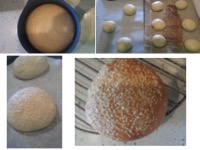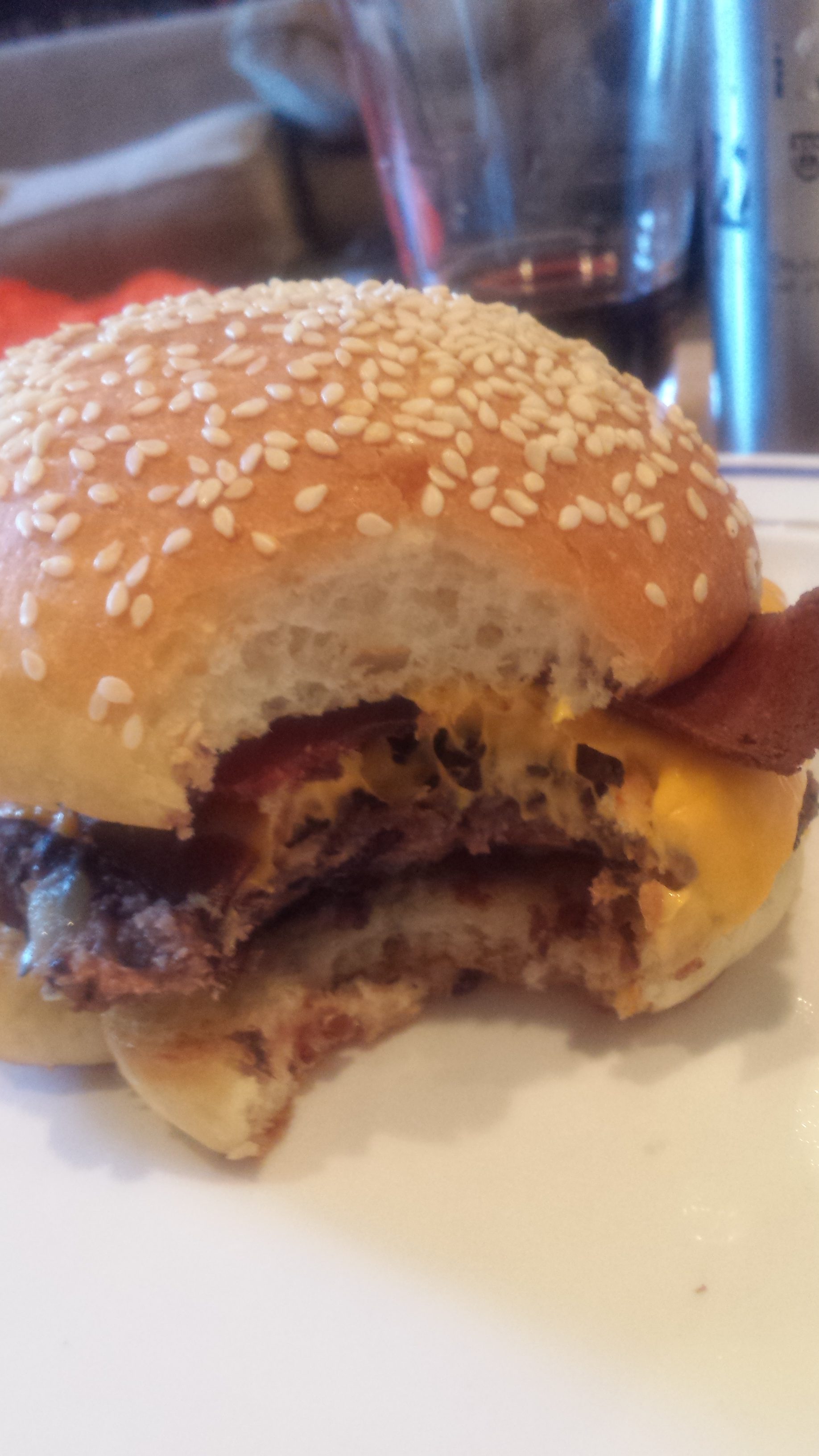The Return of the Black Bean Burger

hey, isn’t that guy Hillary Clinton’s husband?
Was it just because I was a vegetarian that it seemed like veggie burgers suddenly popped up everywhere in the 1990s, the way that when you learn a new word you’re bound to hear it within the next 24 hours, no matter how obscure? Or maybe it was a trend that I was too young, as a college student, to understand. Overnight, it seemed, supermarket freezer cases stocked Morningstar Farms frozen veggie burgers, fancy restaurants tried to turn portabella mushroom caps into burger substitutes, tex-mex chain Chili’s sold a Bandito black bean burger (terrible name, fabulous burger), and every vegetarian cookbook had at least one recipe, preferably with brown rice and lentils. In addition to being the era of oversized flannel shirts, babydoll dresses, and clove cigarettes, the 90s were the age of the veggie burger.
And just like how 90s fashion trends are back in style, the veggie burger is making a comeback, the latest iteration of the farm-to-table movement of the last several years. Farm-to-table started meat-centric, incorporating offal and other body parts that most Americans don’t care for into fine dining. Defined by local sourcing, it’s grown to include restaurants that make vegetables the star, though one has to wonder whether we’ve missed the point of eating veggies for dinner when places start selling 3 roasted carrots for $18. Don’t get me started on the ethics of avocado toast.
But Americans still want to feel like they’re eating a hearty meal, so making vegetables into burger form ticks both the farm-to-table and the comfort food categories. Plus fries are vegetables, so bonus. Superiority Burger has made headlines for its veggie burger, while NY’s Penn Station food hall the Pennsy has several veggie burger options at the Cinnamon Snail. Given that one of this month’s sandwiches is a burger, it seemed only appropriate for me to pop in a Hole cd, unscrew a Snapple mint iced tea and make some veggie burgers for the first time in decades.

chop that onion and pepper fine, son! not like what you see here.
After perusing my shelves of cookbooks and a variety of recipes online, I remembered that J. Kenji Lopez, Serious Eats’ Managing Culinary Director, author, and guru of scientific cooking, had posted a recipe for a black bean burger that sounded tasty. Like many of his recipes, it was a bit fussy. In his quest to recreate tastes and textures, Kenji sometimes makes recipes with so many steps that I bookmark them but know that I’m not going to make the effort even though I love to cook. Time is a huge factor and, let’s be honest, if the deliciousness quotient between a recipe with 5 steps and one with ten isn’t exponential, than it may not be worth it. But, this recipe was fairly straightforward, except for one unexpected step: draining and drying out canned black beans in the oven, with the goal of reducing the mushiness of the burger. Honestly, I don’t mind a little mush and some commenters had noted that the burgers were dry, so I only baked one can’s worth of beans and just drained the other and used as-is. I also made some substitutions. With a serious lactose intolerance, I can’t eat cheese, so I eliminated the feta. To get some of that funky saltiness back, I substituted a tablespoon or so of yellow miso. No mayo, so I threw in an extra egg to bind it. Can’t digest garlic, so used garlic powder instead. Substituted chopped walnuts for cashews, regular bread crumbs for panko and chipotle chili powder for the chipotle in adobo.
Once the mixture was made, I shaped them into 9 patties which looked remarkably like real burgers and put them in the fridge to firm up. Earlier in the day, I started a batch of hamburger roll dough, using this much-beloved recipe from King Arthur Flour’s website. No substitutions there–you don’t mess with baking! The recipe mixed up like a dream, turning into a silky dough after about 7 minutes in my Kitchen Aid mixer. It doubled in less time than called for so watch your dough so it doesn’t overproof. The recipe doesn’t give a weight in ounces for each roll. Googling around learned me that hamburger rolls are around 3 oz. That seemed big, so I played with different sizes. After the final rise, I brushed them with egg wash and counted 187 sesame seeds on the top of each one, just like McDonald’s.** And then they baked up into the cutest little hamburger rolls you’ve ever seen!

from It is Risen to the Bunale!
When dinner time rolled around, I fried up some veggie bacon and then plopped two burgers on the frying pan. They browned in about 4 minutes. For the last 45 seconds or so, I topped them with vegan cheese and a lid to get it as melty as vegan cheese gets, while I griddled the split buns. Assembled together, it looked extremely tasty, but would it live up to Kenji’s hype?

My friends, it did. There was variety in the texture, thanks to the chopped nuts and the dried beans. The chipotle added a spicy undercurrent. The peppers and onions gave it layers of flavor. The rolls were perfect–soft but able to stand up to the burger plus toppings. Plus, each recipe yielded enough leftover for meals for several more days to come.
** this may be a lie. Not that McDonald’s puts 187 seeds on each roll. That’s true. My counting them, however, could be a fib.
No denying it, I like the sensual things of the world, especially good food and drink, though I’m no snob when it comes to either. A background in American cultural history and food studies makes me approach the world with a desire for contextualization and connection on the way to synthesis.











That looks really yummy. and is making want to eat a black bean burger. My problem with vegeburgers in general has always been the dryness, though the best one I’ve had is made by a food van at the annual folk festival in town. He’s been coming every year for the last 20 or so. They’re great! Not black beans though, lentils and something else…